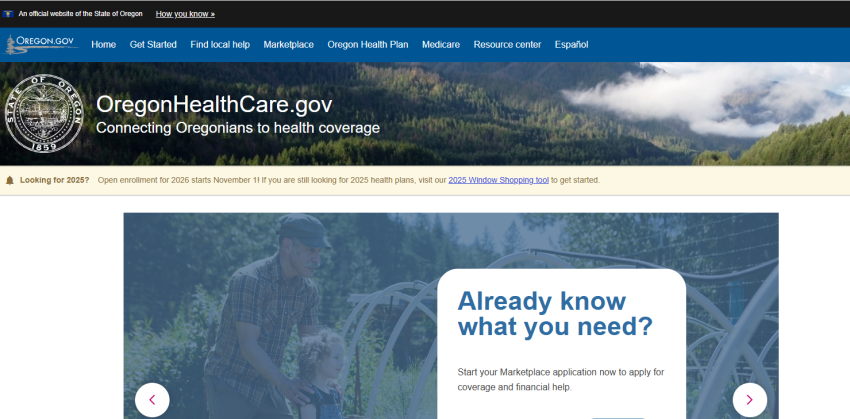Salem, Ore. – Saturday, Nov. 1 marked the start of open enrollment for 2026 private health insurance, the annual opportunity for people in Oregon to secure coverage for the year ahead. Open enrollment – the only time most individuals can shop for, compare, and enroll in health plans – runs through Jan. 15, 2026.
Individuals who enroll by Dec. 15, 2025, will have coverage beginning Jan. 1, 2026. Those who enroll between Dec. 16, 2025, and Jan. 15, 2026, will have coverage starting Feb. 1, 2026.
Through OregonHealthCare.gov, people in Oregon can choose from high-quality health plans offered by trusted private insurance companies:
- BridgeSpan,
- Kaiser Permanente,
- Moda Health,
- PacificSource Health Plans,
- Providence Health Plan, and
- Regence
All Marketplace plans cover essential health benefits, including vaccines, emergency services, maternity and pediatric care, free preventive care and more. Marketplace plans in Oregon continue to provide coverage for reproductive health care and medically necessary gender-affirming care, in accordance with state law.
The Oregon Health Insurance Marketplace continues to serve entrepreneurs, uninsured individuals, and those who recently lost Oregon Health Plan (OHP), OHP Bridge or COBRA coverage.
Local experts are available to help people in Oregon compare plans, identify financial assistance, and enroll in the best plan for their health needs and budget, with no charge for their service.
“We know that navigating health insurance can feel complex, but you don’t have to do it alone,” said Chiqui Flowers, director of the Oregon Health Insurance Marketplace. “Our partners provide free, local help across Oregon – in more than 60 languages, both in-person and online – to guide you through your options and help you find the plan that best fits your needs and budget.”
Expiration of Enhanced Premium Tax Credits
Expanded premium tax credits were initiated under the American Rescue Plan Act in 2021 and extended under the Inflation Reduction Act in 2022 to make health care more affordable for individuals and families in the middle-income range. The expanded premium tax credits are set to expire after the 2025 plan year, unless Congress takes action to extend them. The enhanced savings extended eligibility for premium tax credits to people at or above 400 percent of the federal poverty level – approximately $62,600 for a single adult and $128,600 for a household of four – and expanded the amount of savings available to all Marketplace enrollees already eligible for savings.
When the enhanced savings expire, people at or above 400 percent of the federal poverty level will no longer qualify for savings, and all other eligible enrollees will see their financial assistance reduced. This means:
- Thousands of Oregon enrollees could pay an average of $147-$456 more per month, depending on income level
- Older enrollees with 400 percent FPL could pay $900 or more per month and
- Nearly 35,000 people in Oregon may lose financial assistance altogether.
These enhanced savings have helped many people in Oregon lower their monthly premiums and access affordable coverage. People enrolling for 2026 should review their options carefully to understand how any potential changes may affect their costs for the upcoming year.
Tips for Open Enrollment
- Check your income and household information to make sure it accurately reflects your current situation. Update anything that has changed since last year.
- Use the updated Window Shopping tool at gov to preview coverage options, compare plans side by side, and estimate their savings before applying. Enhancements to this year’s tool include improved accessibility features, mobile functionality and expanded information on covered benefits.
- Watch for proof requests from the Marketplace. If HealthCare.gov asks you to verify your income or eligibility, respond quickly so your coverage is not delayed.
- Know your state protections. Oregon continues to require coverage for essential services like gender-affirming care and offers resources to help you stay insured. If you have concerns about your coverage, reach out to Division of Financial Regulation’s Consumer Advocates.
“This year’s Open Enrollment looks a little different than past years with some enhanced federal support ending and other rules shifting,” said Amy Coven, a communications and public engagement analyst with the Oregon Health Insurance Marketplace. “The Marketplace and our extensive partner network are here to help you get and stay covered with both online and local resources that are available free of charge.”
Financial assistance remains available to most people who enroll through the Marketplace, significantly lowering the cost of monthly premiums.
Visit OregonHealthCare.gov today to explore your options, find free local help, and get covered for 2026.
###
The Oregon Health Insurance Marketplace, a part of state government, helps people get health insurance when they do not have job-based coverage, and do not qualify for the Oregon Health Plan or another program. The Marketplace is the state-level partner to HealthCare.gov. For more information, go to OregonHealthCare.gov.


